Sunday, December 28, 2008
Malfunctions everywhere, nor any drop to drink
We officially apologize for not having a blog entry, this past week. Helena, who was due to write it, was delayed in her Chicago visit by three days due to the inconstant weather's effects on air traffic.
I tried to take a picture of a really cool antique book-shaped matchbox cover to show you guys today, just to tide you all over until our next blog entry ... but the store's digital camera refuseth to connect to the computer. Any computer. Reinstallations accomplish naught.
So my dear readers, technical difficulties afflict us to an extent too large for our poor little blog. But we'll be back! Expect us on the next slated blog entry date, which -- since we schedule them every two weeks these days -- shall be the Wednesday after this coming Wednesday.
Take care, all, and happy New Year!
Wednesday, December 10, 2008
Atoms are our friends; Blagojevich is not. Are P.T. Barnum's sideshows?
Why Helena would want to return to Chicago, city of vice, for her holiday is her business. Recent events with Governor Blagojevich have hurled Illinois once again to top the list of Dens of Sin. Our history -- partly encapsulated in this week's Favorite -- has always been thus:

"The Light" was apparently a regular magazine that considered itself the "official organ of the American Purity Foundation"; this is the 1911 issue, which had a special feature on vice in Chicago. Specifically, the article is titled "The Social Evil in Chicago", and begins with an amazing rundown of recommendations -- firstly, the appointment of a Morals Commission, and secondly the establishment of a Morals Court. Many proposed ordinances follow! Other articles of note include "The Prevention of Insanity" (including a subheader: "The Relation of Alcohol to Insanity") and "The International Conference Relative to the Repression of the Circulation of Obscene Publications". I wonder if the American Purity Foundation's solutions could be applied today? For $75.00, I suggest that you purchase this fine magazine, study it, and let me know. Maybe together we can prevent another Blagojevich.
Blagojevich is not our friend. But this Affordable and Interesting book can tell us who is:

That's right -- the atom is our friend, and in 1956 Walt Disney produced a book to tell us so! Author Heinz Haber writes at the beginning that although "we all know the story of the military atom, and we all wish that it weren't true," and although "so far, the atom is a superb villain", "it is up to us to give the story a happy ending" -- to "make a hero out of a villain". It's "a story with a straightforward plot and a simple moral"!
This vintage paperback is basically a history of the scientific discovery of the atom, but it's noteworthy both for the chipper "Hey kids, aren't atoms great?!" tone and the fabulous 50s graphics. At $5.00, it makes the perfect gift for anyone interested in both 1950s nostalgia and the history of science. I wonder how common people like that are.
People without arms are not common. And least common of all are people without arms like the one pictured in this Collector's Item:

Ann E. Leak was a remarkable woman: born without arms, she simply learned to do everything with her feet. Really. Everything. Look closely at the (regrettably a little faded) photograph above, then read the back:

"This is a specimen of toe-writing," proclaims the calligraphy. Miss Leak sold these cards while traveling both on her own and as part of P.T. Barnum's circus -- toe-writing all the while! She even published an autobiography, describing good times roaming America and Australia. Interestingly, she believed she was born without arms because her father, an alcoholic, came home from the pub with his coat thrown over his shoulders without his arms in the sleeves, and her mother saw this image while pregnant with Ann (click here). We are selling this photograph of Miss Leak for $250.00, but we certainly have no idea why she was born armless. If you do, please leave a comment!
Hyde Park is probably quite charming over Christmas, but I won't know because I'll be away. Welcome Helena next week, gentle readers, and I'll see you in January!
Sunday, December 7, 2008
Help us be eco-friendly! And read about charming popup books!
Also, gentle readers: do you shop at local grocery store Treasure Island? If so, you may have noticed that they use very good-quality plastic bags. Here at O'Gara and Wilson, we must buy quite thick plastic bags, because books are heavy and require good bagging. But because Treasure Island uses such sturdy bags, we are initiating a new program: We will re-use your Treasure Island bags if you donate them to us!
So, please help us help the environment by giving us your old Treasure Island bags!
Wednesday, November 26, 2008
In which we finally find out: "Why World's Fairs?"
Our first Fun Books should thrill many Collectors:

John Lange, you say? Who is John Lange and why do I care? Perhaps you recognize this author's real name better: Michael Crichton, who died recently at the age of 66. Crichton is most famous for science fiction thriller classics like The Andromeda Strain and Jurassic Park, but he wrote his first books as John Lange. In fact, his very first book ever was Odds On (1966), and here we have the first printing of the first edition! You could purchase that for $200.00, or perhaps you could go for the cheaper first edition of Easy Go -- a slightly later "Lange" book for which we're charging $75.00. I can't quite decide which of these two lurid paperbacks makes me happier, but I think that if I were buying one, I'd pick Easy Go entirely because of the cover blurb: "Rob the tomb, hijack the harem -- five master criminals plot history's hottest heist on the banks of the Nile!" (I'd tell you all about the descriptions on the backs of these books, but they are just too scandalous. It's worth your time to come into the store and read them, I assure you -- they're quite funny!)
Now for our Affordable and Interesting Fun Book!

Around Chicago, we have a great deal of evidence of the 1893 World's Columbian Exposition -- indeed, we have written about it here on this blog any number of times! I spend an unreasonable amount of time passing the Exposition's leftover buildings during my daily meanderings, and frequently I find myself amazed at the colossal amount of resources that went into that brief festival. I also find myself wondering why in the world such exhibitions were considered worth it -- for there were many of them, not just Chicago's! In fact, I was recently stunned to realize that World's Fairs are still going on (click here for Wikipedia's list of them, or try clicking here to look at the online Museum of World's Fairs).
As it happens, this question is the subject of this very book: The Story of Exhibitions. It's a hilariously pompous 1951 examination of World's Fairs through the ages, seeking to "capture for the general reader something of the romance of exhibitions, which are among the most remakable social phenomena of our times". My favorite line is from the introduction, "Why Exhibitions?": "The first [reason] is, quite simply, the desire to 'show off'." $15.00 will purchase this trenchant observation as well as quite a lot of history and photos of past expositions!
This week's Favorite is more a Fun Chapbook than a Fun Book:

Frans Masereel was a remarkable woodcut artist of the early 1900s. He's best known today for his novels without words, in which he would take evocative titles like The Passion of Man and tell a story without text -- entirely through woodcuts. This little chapbook is a scarce title on Masereel's life and work, with a ten-page written introduction followed by a number of Masereel images:

.

Masereel is sometimes described as "expressionist", and I would have to agree. His images are so powerful and arresting! This would make a really cool gift for any designer or comic artist -- get your arty kid's Christmas gift here, only $25.00!
Man, I never know how to end these blog entries. On the TV show it would probably be even worse -- or maybe there'd be a song that played at the end, or a routine I went through: another kids-around-the-buffalo dance? That would make it easier. I will, gentle readers, think on it. Feel free to comment if you have any ideas!
Wednesday, November 12, 2008
Social engagements of ages past!
You know who liked philosophical questions? Ben Franklin, as featured in this Affordable and Interesting tome.

We all know who Benjamin Franklin was. Even beyond his contributions to the founding of the United States, he was remarkable -- a scientist, a man of the arts, in all ways an accomplished gentleman. As it happens, he was also famous for his ... ahem ... lady friends. Franklin spent eight years in Paris, during which time he won French support for our fledgling nation, and also cut quite a swath through the elegant Parisian ladies he met. This $12.50 book describes Parisian culture from 1777-1785, when Franklin was there, and gives the story of the time he spent discussing ideas; making diplomatic overtures; and most importantly, charming women.
From this week's Favorite we learn that if Ben Franklin had been a student in the 50s, he would have been featured on many girls' dance cards.

Here we have a bunch of social materials from the mid-1950s at the Dunbar Trade School! There are some run-of-the-mill things like ID cards and Dunbar Trade buttons, but there's also great stuff like a "High School Daze Memory Book". It's blank; it seems that no one wrote their memories in it, but that does mean you could give it to your favorite high school student for their own records.
Perhaps you prefer the invitations to Masquerade Balls and New Years Balls hosted by the Gay Eights Social Club -- not to mention the invitation to the annual Hippity Hop hosted by the King of Clubs. (I wonder if the Gay Eights and the King of Clubs were rival organizations?) Me, I particularly enjoy these little Prom booklets:

The booklets contain the lists of Prom Queens and Kings, plus their royal retinues. They contain hilarious Mad Libs about Prom Night (again, blank -- you could fill them out yourself!). And they have dance cards! One of the dance cards is blank, but the other has one name scrawled in pencil across every song's field. ... Dear God! In an incredible moment of synchronicity, I just realized that name is: Robert W. Franklin! Gentle readers, I couldn't make these things up. Do you think he's a descendant of the aforementioned Franklin?! For $50.00, you not only acquire this entire trove of 1950s nostalgia, but the evidence of a ridiculous coincidence.
Which brings me to the coincidence I discovered in this Collector's Item.

Here we have a genuine Victorian photo album, complete with red velvet cover and brass clasp. Below, we have photographed it with another Victorian photo album that we are also currently selling:

The pictures within these albums are mostly the expected Victorian familial photos, featuring severe expressions and elaborate formal clothing. The occasional antique photographer's card is in here as well. But what really excited me was the folded letter I found in that red velvet album, listing the participants in a hair wreath! Many Victorians, being of a fascinatingly macabre bent, would weave flowers and wreaths from the hair of people they knew (find out more by clicking here). So this handwritten page starts with, "Miss Alma L. Denny's hair wreath made, June 19, 1875. A List of the names of the persons that have hair in this wreath." Each person's name is then followed by a description: "my Sister," "my seckond cousin", "a nabor", "a nabor a true friend". (We cannot be held responsible for this person's spelling and grammar.)

The reason this is a startling coincidence is that we ourselves, this very bookstore, sold an antique Victorian hair wreath some months ago (it was even featured on our blog at the time!). I find myself wondering if it's the same hair wreath. Not that it matters overmuch, since our wreath is long sold to a happy customer, but $150.00 buys the red velvet album ... and the mysterious letter as well!
That's a wrap, gentle readers. It was nice to visit. I understand that Alan is updating once every two weeks these days, so I guess you'll hear from him in a couple weeks. Or perhaps I'll return myself. You shan't know what to expect ... and in the meantime, take care!
Wednesday, October 29, 2008
The Haunted Bookshop
Dear Blog Readers,
With trembling fingers I type these words, a vain attempt at leaving some record of what has transpired in the last hour. The bookstore has become a terrifying prison, and all signs indicate escape is impossible -- for I have become my own incarcerator! What did I do? What law did I break, what suffering did I cause, that I should be forced to live such monstrous events, descend into what can only be madness, and live out my final moments writing words that won’t be read – a letter from the very depths of Hell itself.
This morning nothing seemed out of the ordinary, and, like any reasonable person, I would have scoffed to hear but half the things that this letter will have you believe. At 10:00, as usual, I removed the sturdy padlock on the steel security gate that protects O’Gara and Wilson from after-hours undesirables. How was I to know that the least desirable things can slip between bars and under doors, hide between books and even in dark crevices of your own brain! Like the coin of Janus, I weep and laugh at this tragic irony, and so, perhaps, will you. For today was the day for blog-writing, and I was particularly excited to write something frightening, in anticipation of Halloween. (One can only suppose that the persistence of this gruesome pagan holiday, a ghastly carnival, with ritual indulgence of appetite, deception and disguise, the corruption of youth and inculcation of spirit-fears, can only be accounted for by supposing that the otherworldly denizens to whom it does homage must really exist. And indeed, dear Lord forgive me, they do, and are far beyond the pen of Dante himself to describe, or Duhrer to depict.)
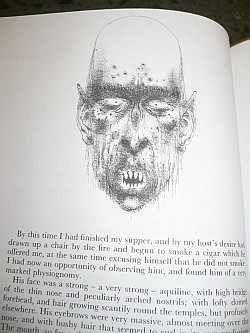 .
. 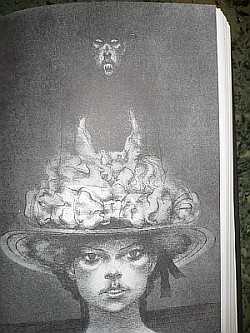 .
. 
As I thumbed approvingly through its pages, pausing longer at the darkest, most evil drawings, a tremendous crash rang out behind me. I turned immediately to check on the situation at the front of the store. Though I was undeniably alone, the collection of Egyptian metal plates was scattered everywhere, and the largest piece, a bronze table-top, had landed in middle of the display window, crushing a number of books and knocking others over. This shocking discovery occupied my immediate attention for quite some time, and so it was only later, as I tried to clean things up and sort out a reasonable explanation, that I noticed the windows were completely dark. I couldn’t see outside. Even the glass in the door was dark, but I could dimly make out the shadow of the steel security gate, which had somehow been pulled shut and secured with the padlock. I called out a number of times, but no one answered. Calm down, Alan, I told myself over and over again. Just calm down, think rationally about all the evidence. But calming down was extremely difficult, especially when the books began to fall off the shelves. First two or three in philosophy, then an artbook, then something from political science in the back. Suddenly there were hundreds flying through the air, some very near my head, like horrible leather-winged bats. I received several serious paper-cuts on my face, and dropped down huddled on the floor, with my hands behind my head to protect my neck from the sharp hardback corners. Only moments later the lights snapped off, and everything went silent and still. At this point I am entirely crippled with fear, begging for mercy from some power that had obviously decided to ignore me completely. A dim light showed from the first aisle, where we keep the occult books. Like a madman compelled by some force he doesn’t understand, I moved slowly towards the glow, which seemed to be coming from behind the books themselves. Upon close inspection I realized the light was coming from the books themselves! Three, to be exact, and with a stroke of irony let me make them this week’s Collectible, though woe betide their future collector! The paper spine label reads “The Proceedings of the ASPR”.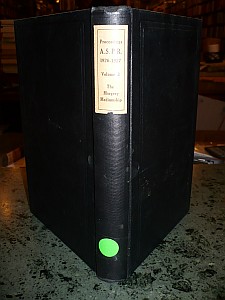 .
. 
I began reading a volume at random, which according to the note in the back was unavailable at any other bookstore.
Quickly I found that ASPR stands for the American Society for Psychical Research, and this particular volume concerned their research into something called the Margery Mediumship. You can imagine my horror when a high, thin voice began to wail softly, ‘Margery. Margery dear, is that you?’ I wheeled around -- nothing. ‘Now turn off the lights, Margery, there’s a good girl. You know how I don’t like the lights Margery, I really don’t like them.’ The voice sounded unhappy, and I dropped the glowing book on the floor, backing slowly away. ‘Margery. Turn it off, Margery, turn it off, off, off!!! It’s killing me Margery, do you want me to die, Margery, because I know you don’t want to die, turn it off, off, off!’ The book became blindingly bright, and I must admit that I passed out from fear. When I awoke, the books were still strewn about the store, but the lights were on. The secondary store computer was also on, though I hadn’t touched it yet, and a CD was playing old blues music. Slowly I stood up and began walking to the front of the store. After only a few steps my right foot slipped out from under me, and I fell, scraping my head badly on an old vintage typewriter behind me. At my feet was a pool of blood, far more than could possibly have come from my injury. A drop fell in the pool. Then another. I looked up, and saw a thin red stream oozing out of the heating vent.
Bang! Bang! Bang! The vent shuddered three times. ‘Mother,’ called a voice. ‘Mother, are you still there?’ The banging again. ‘Help me, please,’ said the voice. ‘Someone please help me.” And still again the banging! Numbly, I went to get one of the tall, rickety wooden ladders for accessing higher shelves. My mind was concocting all sorts of ridiculous stories: perhaps a young girl was stuck in the vent by her mother. That would explain things, I thought. She needs to be rescued. Sure, just rescue the girl, it's probably Margery. How was I to know that I was the one who needed rescuing!? I climbed the ladder, and the banging ceased. ‘Mother?’ ‘MOTHER!’ The voice went from feminine whisper to guttural snarl, and from the vent burst the cause of my eventual madness, the beast of darkness behind the blood and voices. The only way to save me from it, I fear, is by reading this week’s Favorite, the unnassuming sllsk red;las nl;aksh;ll;lk
_____________________
Wednesday, October 8, 2008
Elect O'Gara and Wilson! We Exist!
Dear Readers,
After the slew of e-mail responses (no, really, 1 comment definitely counts as a ‘slew’) I’m changing the topic of conversation to something a little more controversial: politics. Fear not – this blog takes no sides. Or rather, I’m so amused by the ridiculous rhetoric of our candidates and this media circus of an election, that there’s really no time to take sides. Let’s start with the fact that these guys both sound like robots – boring, boring robots programmed to be as inoffensive as possible. See, there’s no real way to be sure what either candidate actually thinks – they’re both paralyzed by the desire to get elected, which restricts them to platitudes, tautologies, and catch phrases. These, of course, are decided upon by handlers, advisors, and strategists, a horde of game-players that use each candidate as a loudspeaker for their calculated nonsense.
Let’s take a great platitude: “Absolutely, I believe in America.” My goodness! Do you really? What exactly would it mean to not believe in America? America is not Bigfoot, or a fairy, last I checked. The tautologies are slightly longer, disguised by length to mask their utter meaninglessness: “Certainly, the economy falls and rises, but American workers continue working, and markets will be controlled by factors that we are responsible for. As Americans, and as people, we participate in this country, and as president I’ll work for the country, to make sure that justice is justice.” How illuminating! I was under the impression that the economy only rose, Americans were not by definition people, and the president worked for General Electric.
And don’t even get me started on the catch phrases! Holy-moly, if I hear Obama mention McCain’s statement about the “fundamentals of the economy,” or McCain bring up “earmarks,” I’m going to, well, actually, I’m going to do what we should all do. Head down to O’Gara and Wilson, where numerous books can help you free yourself from the haze that inevitably envelops all who pay attention to political discourse.

So let’s go back even further. This week’s Collectible is a leather bound Easton Press edition of The Prince, by Machiavelli. 
Looks like politicians may have been doing their reading after all. From O’Gara and Wilson, this is Alan, over and out.
Thursday, September 25, 2008
The Survival of Used Bookstores, A Digression
Let me put your curiosity to rest. The Scriptorium monk represents care for the printed page, a connection with times long past, when an author's text required the hand of a craftsman for its completion. In the mid-1800's book-binding machines began to catch on, slowly reducing the concept of "book" to nothing more than an efficient means for distributing ideas. Mr. Wilson and Jerome, as he is fondly called, still cherish the idea of book as artifact, something the significance of which depends not merely on the meaning of the words within, but is continually shaped by all those who share in its history, from the author to the customers that frequent second hand bookshops.
And the buffalo? Both he and Mr. Wilson represent what biologists refer to as a “keystone species.” A keystone species has a disproportionately important effect on its surroundings. Though its presence may be small in terms of population, the existence of a keystone species is crucial for sustaining diversity of life in its environment. When such a species goes extinct, the ecosystem that it supports falls apart, like a bridge whose keystone has been removed. Mr. Wilson and the store he runs are a powerful if subtle force, shaping the Hyde Park community and consequently the world. Luminaries like author Saul Bellow and theologian David Tracy have found fuel for their intellectual furnaces here, at this well-stocked woodpile of ideas, whose logs are daily gathered, bundled, and delivered by the bibliotaph (one who caches or hoards books) of whom we speak. Not to mention the many others who pass through our doors, hoping to stumble upon some synchronicity that radically changes their perspective. One can only imagine what would happen to the diversity of life and thought in Hyde Park if O’Gara and Wilson were to be replaced by, say, another Borders.
And that brings me to the most important part of this blog, namely the crucial difference between Mr. Wilson and these two fixtures of his bookstore. Not only is he still alive, but Mr. Wilson plans on continuing to thrive. He will not bow to the cultural forces that escorted monastic scribes and majestic herds to their respective graves. This keystone species, at least, is fighting and winning. The used bookstore’s struggle to survive can take many forms. Mr. Wilson is unique in that he employs a three-pronged approach. In fact, he himself has suggested the metaphor of a three-legged stool. This term was supposedly coined by Oxford scholar Rev. Richard Hooker, in reference to the Anglican church (sorry, Jerome) and the three legs that support it: scripture, reason, and tradition. Our elements are humbler, but no less important to stability. They are high-end auctions (Collectible), in-store sales (Favorite), and the internet (Affordable and Interesting).
Most people don’t know it, but much of the bookstore’s revenue comes from consigning very collectible books and items to auction houses. These venues have an international audience, ranging from university libraries to enormously wealthy private collectors. Here are some examples:
http://www.swanngalleries.com/index.cgi
http://www.bonhams.com/
While your average walk-in customer may not have the necessary liquidity to purchase Shakespeare’s hand-written first draft of Romeo and Juliet (originally entitled Romeo and Bernice, it appears), auction houses allow Mr. Wilson to distribute such items through the proper channels.
But whence these auction-worthy artifacts? Is Mr. Wilson some sort of latter-day treasure hunter, digging under every Hyde Park oak until he discovers the secret stash of an eccentric Shakespeare scholar? Do kind souls simply drop box upon box of their Loeb classics on our doorstep? Nuh-uh. Aquiring a truly magical used bookstore inventory is a simple function of customer relations and rapport with fate.
Let me explain. Quite often it is long-time bookstore patrons who provide us with our wares. We have seen books come back through that were once sold by Mr. O’Gara over thirty years ago. Without long-term customer relationships our store would be dead in the water, not only because no one would sell us any books, but also because many people wouldn’t have cool books to sell. Just as often, though, sheer chance seems to bless Mr. Wilson with extraordinary caches of books and objects, although when something chancy occurs on a regular basis it’s usually due to something. But how do you explain this –
 .
. 
a German hand-grenade storage box, converted by an army chaplain into a container for bibles and altar cloths. Talk about swords to plowshares – and a serious instance of the book as a historical artifact. Good luck finding another one of those, or any of the other strange confluences of events that can be found and purchased at O'Gara and Wilson…
Unfortunately, the gusts of modernity will overturn any two-legged stool. Science and technology vigorously trumpet the demise of feeble furniture: “Physically impossible!” they cry, or “I can buy a three-legged stool for less online!” until the vast majority of two-legged-stool-used-bookstore-hybrids are chopped into metaphorical kindling, to be sold somewhere else, or failing that, to be unceremoniously dumped in the dustbin of history. We have not remained in the Luddite past of unscientific bookstore cavern-people. Like some nuclear accident that results in a positive mutation, we evolved a third leg. The internet.
http://www.abebooks.com/servlet/ListingBrowse?vendorclientid=78077
That links to our online inventory. You may have thought the appearance of these funny stickers around the store had a deep meaning –
-- discounts, perhaps, or a pox with a tendency to infect more expensive academic texts. Not so. These are the brands of the internet, bright marks of our submission to a new order. Orange dot: book might go online. Green dot: book is online. Some days we sell more books online than we do in the store. Much clerk time goes into putting books online, or searching the internet for prices so we can be the best deal in town (that is generally how we price our books, in line with the lowest online prices). There is a new competitive force; the open market of the internet has changed the face of bookselling. Now a beautiful art book might be worthless because so many were printed, but an expensive Russian calculus book might be salable to a client overseas. There are drawbacks to the internet, but for a store like ours there are also advantages, provided we are ready to use them. Right now, in fact, you are helping us with another aspect of the mutant technological third leg, just by reading this blog. Go on, write in! Let us know you made it this far through the blog! Let us know you’re out there! Come into the store, and say – the blog technology brought me here!
Uh-oh. Things are getting a little out of hand. I think we covered everything we set out to cover – from O’Gara and Wilson, this is cyber-Alan, wishing you a three-legged future with Jerome.
Wednesday, September 17, 2008
To picture or not to picture...
Dear Readers,
The focus of our current blog is a topic close to my heart – the illustrated book. There is no question, of course, that certain types of books benefit from illustrations. One shudders at the thought of a cookbook entirely bereft of pictures, and an art-book without some reproductions of the works it treats seems, at least to me, entirely pointless. But the relative value of illustrating fiction is not so easily decided. Tolkien himself, in his essay “On Fairy-Stories” complains that illustrating such tales deprives children of the opportunity to imagine things for themselves. This, of course, from an author who illustrated the Hobbit himself. While Tolkien doesn’t count the Hobbit as a fairy-story, it seems plausible to extend his argument to all illustrated fiction. Somehow, the act of reading is essentially an imaginative one, and illustrations restrict the reader’s freedom, imposing particular images onto the blank canvas of the text.
I’ve heard people make similar claims about movies – Christopher Tolkien wanted nothing to do with the film adaptations of the Lord of the Rings, saying they were peculiarly unsuited to film, and his father has been quoted as hating all things Hollywood. After watching the cinematic form decimate favorites like The Phantom Tollbooth and The Hitchhiker’s Guide to the Galaxy, some might be inclined to agree. But the issue is more complicated than that. Certain books might be bad material for film adaptation. Others, like Gone with the Wind, Pride and Prejudice, and One Flew Over the Cuckoo’s Nest, do quite well, in my opinion. There is, I think, no standard rule to be applied in this case. Plays, needless to say, are actually meant to be performed – with Shakespeare or Beckett we should have no compunctions about restricting the reader’s imagination with a movie or performance, since the reader is actually meant to be a spectator. A book that has been singled out as impossible for adaptation (Sterne’s Tristram Shandy, for instance), is simply waiting for a talented film-maker to rebut the claim.
So when should something be illustrated, and when should things be left to the reader’s imagination? Do the same rules apply – can a good illustrator always rebut the claim that a book ought not be illustrated? Perhaps. But maybe a different place to start is the general consensus on which audience benefits most from illustrated books. The answer is easy: children. Modern novels tend not to be illustrated – children’s books almost always are. Indeed, the amount of illustration in a book is inversely proportional to the target age group. (Imagine Dr. Seuss without illustrations!!)
At first this trend might appear intuitive. Kids like pictures. They need them to supplement necessarily sparse narratives, and peak their curiosity. Or do they? “When we are very young children we do not need fairy tales: we only need tales. Mere life is interesting enough. A child of seven is excited by being told that Tommy opened a door and saw a dragon. But a child of three is excited by being told that Tommy opened a door. In fact, a baby is about the only person, I should think, to whom a modern realistic novel could be read without boring him.” G.K. Chesterton makes a wonderful point. Children have vibrant imaginations, lacking in most adults, it seems. Not only that, but our modern attention span has dwindled to a pathetic shell of itself – just look at the length of camera shots in recent movies compared with those of a couple decades past. One could make the case that it is adults who need illustrations to help them imagine things more vividly, especially given the rather dry content and increasing length of the reading material they tend to choose.
You may, at this point, be starting to lose patience. It is my hope, in fact, that you are thinking, “All right, all right, enough already. Where are the pictures of the books? That’s why I read this blog.” Because if you are, it would make my argument that much more compelling. The interest of this blog lies in part with the inclusion of pictures, which spruce up the otherwise dreary procession of letters that currently clog your screen. So without anymore boring, intellectual, adult-oriented prose, I offer three books for your consideration. All are illustrated, and they cover a wide enough variety of target audiences for any interested blog readers to come in and settle this question for themselves.
Collectible
 .
. 
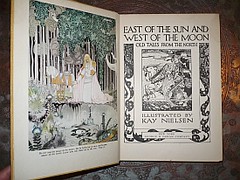
Book: East of the Sun West of the Moon. $200. Target audience: Children (and wealthy adults). Illustrator: Kay Nielsen. One of three greats from the golden age of book design and illustration (Arthur Rackham and Edmund Dulac are the other two). He is my favorite of the three, due to his pronounced Asian influence and particular skill with line drawings. This book of Norse fairy tales showcases, I think, his best work. Absolutely wonderful example of the lavish gift books produced during the first half of the 20th century.
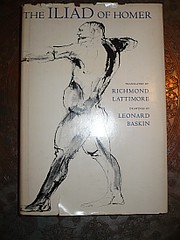 .
. 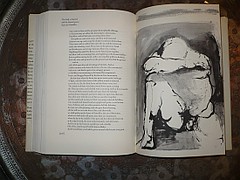
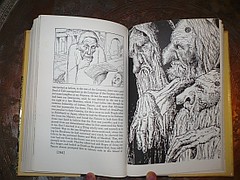 .
. 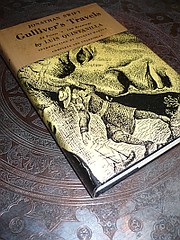
Book: Gulliver’s Travels. $7.50. Target audience: Adults? Children? Illustrator: Luis Quintanilla. Manifestly a book for adults, the fantastical elements of Swift’s “frank and vitriolic satire” (from the dust jacket) are now popularly targeted at children (in abridged editions, a topic for another blog…). Almost every page of this edition is profusely illustrated with Quintanilla’s hilarious black and white prints. A stunning example of graphic art, at a remarkably affordable price.
There you have them. Say whatever you like about the relative merits of book illustration, but make sure your opinion is educated, preferably through a visit to our store.
From O’Gara and Wilson, this is Alan, over and out.
Wednesday, September 10, 2008
Dear Readers,
Part 1: Collectible
“The history of mankind, as a history of the human spirit, may be thought of as consisting of two elements: an escape from this world to another; and a return to it. Chronologically speaking, these two movements, the rise and fall, represent the whole of human history; and the two take place microcosmically many times in peoples and nations…
The nature of haiku cannot be rightly understood until it is realized that they imply a revolution of our everyday life and ways of thinking.
…Haiku record what Wordsworth calls those ‘spots of time,’ those moments which for some quire mysterious reason have a peculiar significance. There is a unique quality about the poet’s state of feeling on these occasions; it may be very deep, it may be rather shallow, but there is a ‘something’ about the external things, a ‘something’ about the inner mind which is unmistakable. Where haiku poets excel all others is in recognizing this ‘something’ in the most unlikely places and at the most unexpected times.”
-- R.H. Blyth (selections from the prefaces)
Flying in by the bamboo-blind,
The swallow is tame
With the beautiful girl.
-- Ransetsu
The kingfisher;
In the clear water of the pond,
Fishes are deep.
--Shiki
In the spring breeze
The snowy heron flies white
Among the pine-trees.
--Basho
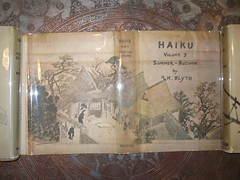 .
. 
Haiku, 4 volume set of first printings, $200.
Part 2: Favorite
I
Among twenty snowy mountains,
The only moving thing
Was the eye of the blackbird.
II
I was of three minds,
Like a tree
In which there are three blackbirds.
III
The blackbird whirled in the autumn winds.
It was a small part of the pantomime.
IV
A man and a woman
Are one.
A man and a woman and a blackbird
Are one.
V
I do not know which to prefer,
The beauty of inflections
Or the beauty of innuendoes,
The blackbird whistling
Or just after.
VI
Icicles filled the long window
With barbaric glass.
The shadow of the blackbird
Crossed it, to and fro.
The mood
Traced in the shadow
An indecipherable cause.
VII
O thin men of Haddam,
Why do you imagine golden birds?
Do you not see how the blackbird
Walks around the feet
Of the women about you?
VIII
I know noble accents
And lucid, inescapable rhythms;
But I know, too,
That the blackbird is involved
In what I know.
IX
When the blackbird flew out of sight,
It marked the edge
Of one of many circles.
X
At the sight of blackbirds
Flying in a green light,
Even the bawds of euphony
Would cry out sharply.
XI
He rode over Connecticut
In a glass coach.
Once, a fear pierced him,
In that he mistook
The shadow of his equipage
For blackbirds.
XII
The river is moving.
The blackbird must be flying.
XIII
It was evening all afternoon.
It was snowing
And it was going to snow.
The blackbird sat
In the cedar-limbs.
--Wallace Stevens
 .
. 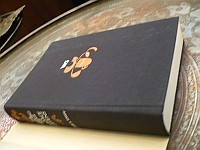
The Collected Poems of Wallace Stevens, 1982 printing, $7.50
Part 3: Affordable and Interesting
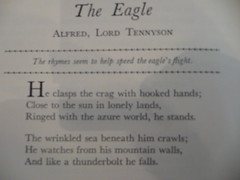

Sections on rhythm, and rhyme, and the music of words. Each poem with a sentence to inspire thought about poetic technique.
The Poet’s Craft: Selected Verses, Daringer and Eaton 1935, $10.50
Wednesday, August 27, 2008
Dear Readers,
I sincerely hope the whirlwind of changing blog authors and new employees has not been too dizzying. That said, I must introduce yet another member of our staff. His name is Jerome.

As you have no doubt guessed, Jerome is a monk. He can be seen in this photograph working hard on the ledgers, meticulously copying columns of records in order to... Hold on a moment. I hear a faint voice calling from the back of the store.
Sorry about that. Jerome has informed me that he tires of his mindless drudgery, hour upon hour of the same boring tasks that occupied him at the old Scriptorium. I offered to let him write this week's blog, and he seemed greatly cheered by the prospect. My apologies if the writing is dry or the topic dull. Without further ado...
Dull? Dry? He's got some nerve, that Alan, implying we monks sit around all day discussing how many angels can fit on the head of a pin, or debating the intricacies of Trinitarian doctrine. I'll give you readers a, what do you call it, an Internet Grog, I think Alan said, that's both educational and stimulating.
In fact, speaking of grog, you should know that many monks like myself specialized (and still specialize) in the brewing of beer. We've been a fun-loving bunch for ages. Hopped barley beer first appeared in the charter of a Benedictine abbey in 768. Water was often contaminated, and beer provided a safe alternative beverage, since boiling is a step in the brewing process. The quality of this fine product improved generation after generation, and eventually brought fame to monastaries. Over 500 monastic breweries existed by the year 1000, producing beer both for sale and consumption by their members (a slightly weaker version was even developed for nuns). Of course, some stick-in-the-mud monks have tried to curb this habit -- pun observed but unintended. In 1664, the Abbot of La Trappe felt things were getting a little too liberal, and passed the Strict Observance, permitting only water to be drunk at the monastery. Needless to say, righteous monks like myself were loath to comply, and I have it on good authority that many disobeyed the regulations and continued to brew tasty beer in secret. This is no longer necessary, thank goodness, as the rules have been relaxed considerably since then.
Ironically, monastic beers experienced an explosion in popularity and quality during the 1920's and 30's, precisely when this nation enacted its own Strict Observance. Of course, if monks were unable to desist from beer making and drinking, Americans were even less likely to do so. Alcohol thrived during Prohibition, and the main character in this week's Collectible was accused of making his fortune in bootlegging. 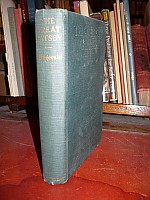
Jay Gatsby -- monk at heart? Alan has been reading over my shoulder, and insists I mention the fact that this is a first edition of The Great Gatsby. Of course, at the Scriptorium, all editions were first editions, since they were copied by hand, but that's another matter. So there you have it, a first edition of the Great Gatsby, excellent reading for those who are interested in life during America's time of Strict Observance. Needless to say, F. Scott Fitzgerald did not observe strictly. He was a heavy drinker, and it interfered severely with his writing later in life. In fact, if you look closely at the photograph below, you might see a slight shakiness in his signature. 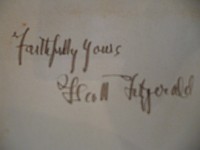
Yes, that is F. Scott Fitzgerald's signature, in a copy of his Flappers and Philosophers. These two books are priced at $1950 and $6500 respectively. Drink some good Trappist ale and perhaps you'll be less reticent to make the purchase.
If your tastes run more towards beer than literature, as mine do, you will probably be tempted by the Affordable and Interesting items this week. 

Practical Points for Brewers was published in 1933, the year that Prohibition ended. Along with this fine volume there are scores of advertisements, pamphlets, beer-brewing manuals, and other printed material of related interest available for purchase. Prices range from $5 for one page ads to $75 for the scarcer books. They provide a wonderful window into the world of early 20th century American beer and alcohol. Personally, however, I wouldn't use the reference materials to actually brew beer -- I borrowed one of the volumes, followed the instructions rigorously, and came up with some pig-swill that I wouldn't wish on the man behind the Strict Ordinance. A friend of mine said it tasted a good deal like Miller High Life, which makes sense -- in 1933, Miller dispatched a case of said beer to President Roosevelt, celebrating the repeal of the 18th Amendment. Knowing this makes me feel better, since it means the poor quality was the fault of the method, not the brewer. Alan is again reading over my shoulder, and wants me to add that the thoughts and opinions expressed in this grog (sorry, blog, I'll get it straight from now on, thanks Alan) belong solely to the author. Alan himself is a fan of Miller High Life.
With all this talk of alcohol, and the mention of Mr. Fitzgerald, it is fitting to mention one of the most eloquent testaments to the beauty of drinking, though The Rubaiyat of Omar Khayyam concerns wine, not beer. 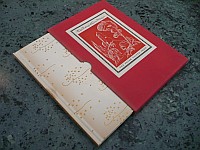
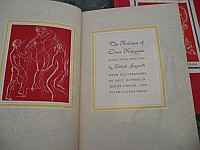
Translated by Edward Fitzgerald, the poem beautifully twines drinking and living: "So when that Angel of the darker Drink / At last shall find you by the river-brink, / And offering his Cup, invite your Soul / Forth to your Lips to quaff -- you shall not shrink." I shall not shrink, thank you very much. This particular edition, and the Favorite of the week, combines my greatest loves -- good drinking, divinity, and quality bookmaking. Peter Pauper Press produces quality, affordable books ($6.00 for the one pictured here). Interestingly, despite his fame as a translator of this poem, Edward Fitzgerald did not resemble the later F. Scott in his actual drinking habits -- in fact, he was a vegetarian who destested vegetables, and subsisted entirely on a diet of bread, fruit, and tea. Perhaps he didn't pay close enough attention to the meaning of what he was translating -- a mistake often made by scholars.
Wednesday, August 20, 2008
Up Front and Personnel
Dear Readers,
Allow me to introduce a blog entry concerned with introductions. Recently, new forces have been introduced at O’Gara and Wilson, forces that are redefining the store from top to bottom, back to front. It would be an admirable day’s work if we could cover one of those areas -- I propose starting with the front.
Most importantly, there are new faces to be seen there. Sarah and Kim are now a part of the staff, helping in our mission to exchange one type of printed material for another. Lest you underestimate the power of their presence for this institution’s feng-shui, witness another significant change to the storefront, due in no small part to their efforts. Alongside Helena, these two dedicated craftswomen reshaped the glass cases, sculpting a thing of beauty that rivals any of its component parts. 
Organized by topic: done. Arranged by size: done. Sorted by aesthetic appeal and age: done. In honor of their efforts there will be a ONE-WEEK SALE on the choicest Collectibles we have to offer. From the opening chime of the register on Saturday, August 23rd until the thump of the deadbolt next Friday evening, every single item in the glass cases will be discounted 10%.
Wait just one moment, you say. Hold on. What about the really high-end stuff? What about the signed T.S. Eliot, say, or the first folio Shakespeare? Surely those are not 10% off?
Do you think Mr. Douglas Wilson, owner and moral backbone of O’Gara and Wilson, would ever allow the electric ambassador of his business to disseminate deception? Never! First of all, the signed T.S. Eliot will absolutely be discounted 10% -- either one (yes, we have two). As for the first folio Shakespeare. We don’t have a first folio Shakespeare, and I never claimed we did. But for those that got their hopes up, rest easy. The Norton facsimile first folios partake of the same discount as every other item – either one (yes, we have two).


And they are much more reasonable -- $125 regular price, so you do the math.
Now that we’re up in front by the glass cases, I should mention a new policy introduced by the city. No longer is the beloved bargain book cart allowed to make its daily pilgrimage to the sidewalk. Chicago, ever thoughtful and clear-headed about the orderliness of its streets, has informed us via local agents that a fine will attend any such excursion. In protest of this unjust imprisonment, the week’s Affordable and Interesting item is taken from this humble cousin of the glass cases. 
As you may or may not be aware, every paperback on the cart is $1, and every hardback is $1.50. Big deal, right? That’s where bookstores put all the crap they can’t sell… Think again, my friend, because things don’t work that way here at O’Gara and Wilson. Ask any of the book dealers who occasionally go treasure hunting through the contents of the cart. Or examine this gorgeous copy of Beowulf, illustrated in color and black and white by Lynd Ward, plucked freshly from the top row of bargain books. That’s right, only $1.50.

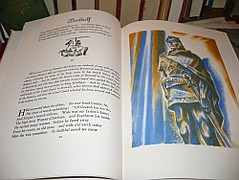
Of course, without the cart our window will have time to shine. Here you can see an assortment of high-quality art books featured there, all priced between $5.00-12.50. 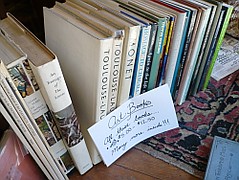
The sign suggests more such treasures inside. Again, you may think we cannot resist exaggerating the extent of our selection – perhaps most of the books inside are paperback, or more expensive than those in the window. This week’s Favorite will put to rest any such notions, while simultaneously facilitating another introduction, this time one of my favorite illustrators. 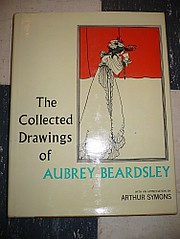

Aubrey Beardsley does extraordinary work, some of it playful, some fantastical, some erotic, and nearly all of it intricate and beautiful. I found a wonderful book of his collected drawings inside on the shelf, when I was looking to verify the claim of our storefront sign. Price: $6.50.
